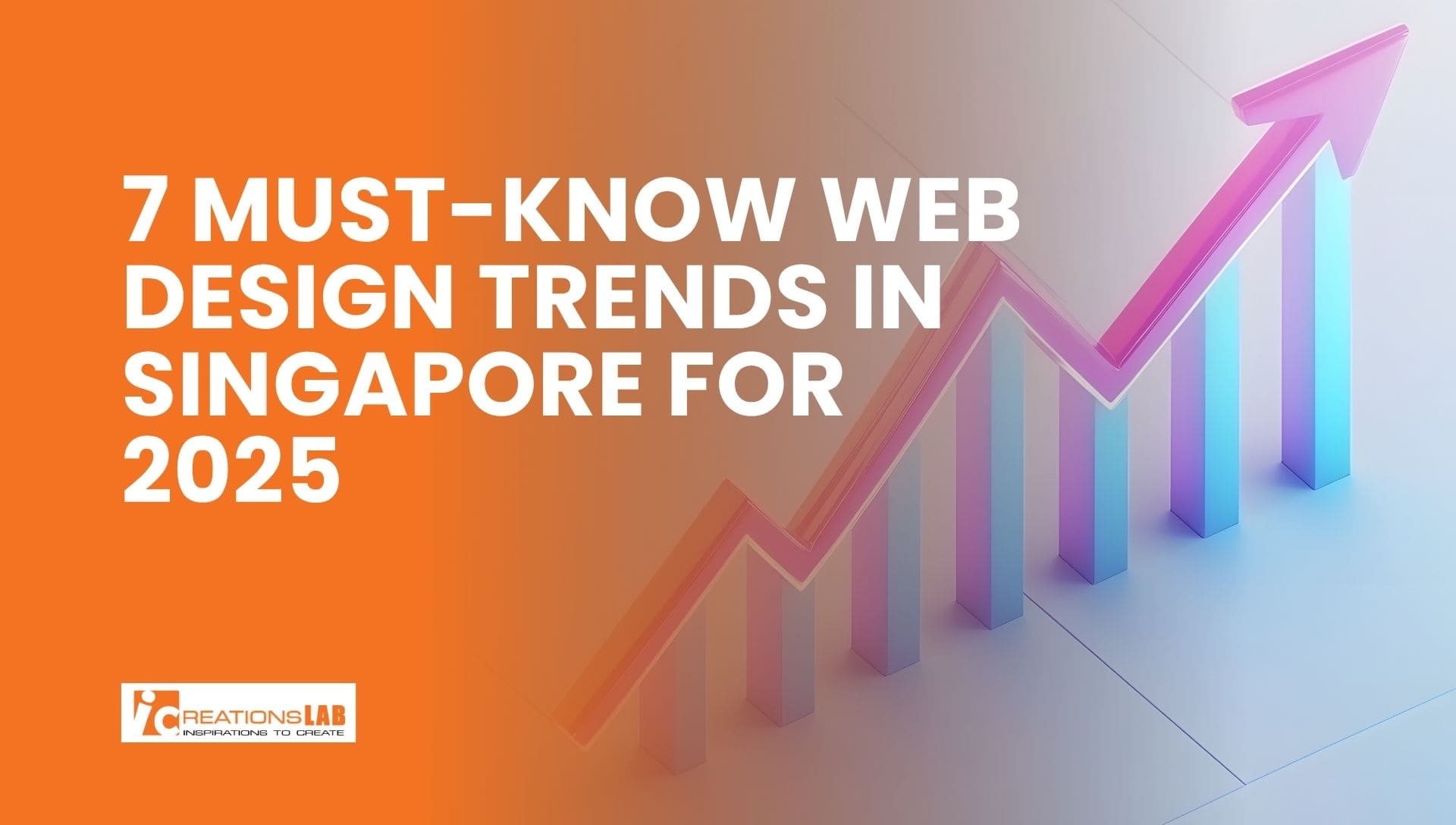Singapore’s digital economy continues to grow rapidly, with more businesses depending on high-performing websites to attract customers, build trust, and generate revenue. With competition rising across all industries, companies are increasingly looking for website design services Singapore that go beyond aesthetics—sites must perform, convert, and support real business growth.
In 2025, consumers expect fast, interactive, mobile-first digital experiences. Meanwhile, search engines reward websites that focus on usability, performance, security, and helpful content. This shift has brought new emphasis to web design trends that directly influence a site’s ability to generate leads and sales.
This article dives deep into seven major web design trends in Singapore that can transform a traditional website into a revenue-driving “cash machine.” These insights are purely educational and aim to help business owners, marketers, and designers understand what truly matters in modern website design.
Trend #1: High-Performance, Speed-Optimized Websites

Website loading speed is no longer optional—it’s a non-negotiable. In Singapore’s fast-paced digital environment, users expect a site to load in under 3 seconds, especially on mobile networks.
Why Speed Matters in Singapore
- Singapore has one of the world’s highest mobile internet penetration rates.
- Users quickly bounce if sites lag—especially in eCommerce and service-based industries.
- Search engines reward fast websites with higher visibility.
How It Turns a Website Into a Cash Machine
- Faster load time → lower bounce rate
- Quicker user journey → higher conversion
- Better rankings → more organic traffic
Speed optimization has become one of the core expectations when businesses look for website design services Singapore because even one-second delay can drastically reduce enquiries and sales.
See More: How to Choose the Right Web Development Company in Singapore
Trend #2: Mobile-First & Thumb-Friendly Layouts
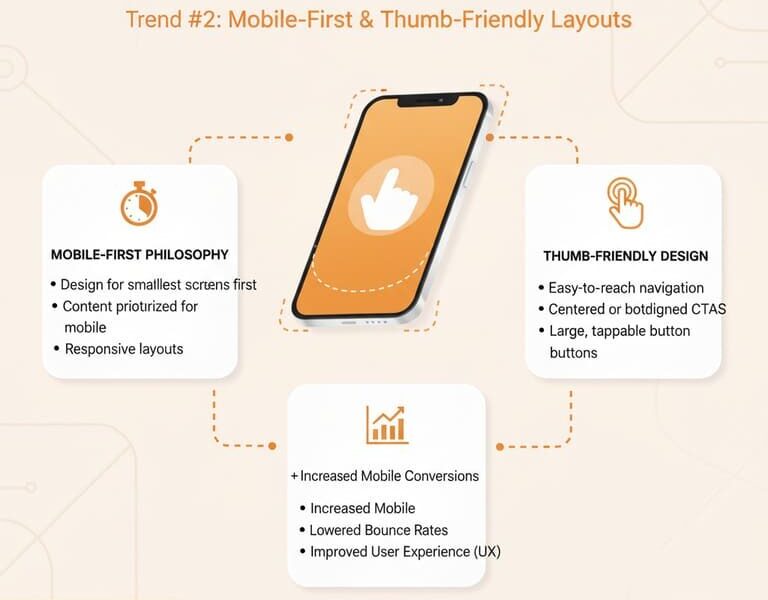
More than 70% of website visits in Singapore happen on mobile, especially from TikTok, Facebook, Google searches, and WhatsApp clicks.
Mobile-First Is Now Mandatory
Modern web design in Singapore prioritizes:
- Large clickable areas
- Vertical layouts
- Sticky contact buttons
- Easy-to-tap CTAs
Designers now create the mobile version first, then scale to desktop. This ensures the most important content appears immediately, improving both usability and conversion.
How It Drives Revenue
- Users can take action instantly: call, WhatsApp, or submit a form
- Frictionless navigation improves lead quality
- Mobile intuition encourages impulse buys, especially in eCommerce
A mobile-first approach is no longer a good practice—it’s a foundational feature of high-performing website design services Singapore.
See More: Top 20 Web Design Singapore Companies: Complete Guide
Trend #3: AI-Powered Design, Chatbots & Personalization
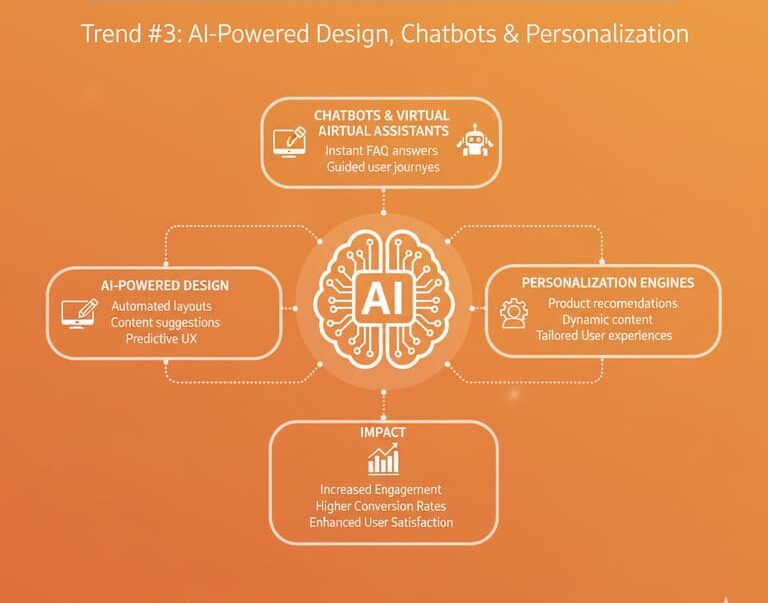
Artificial intelligence is now part of modern web design. Businesses in Singapore increasingly integrate AI-powered elements that enhance user experience and improve efficiency.
Examples of AI in Web Design
- AI chatbots for 24/7 support
- Smart product recommendations on eCommerce sites
- Automated booking and FAQ responses
- Heatmap-based design improvements
- AI-assisted content layout suggestions
How It Boosts Revenue
AI drastically improves customer engagement:
- Visitors receive immediate responses
- Users find what they need faster
- Website flow becomes more intuitive
- Customer support burden is reduced
In 2025 and beyond, AI integration is one of the biggest strengths of modern website design services Singapore.
See More: Best Web Developer Singapore | Build Fast, Secure & SEO-Friendly Websites
Trend #4: Clean, Minimalist Interfaces With High Readability
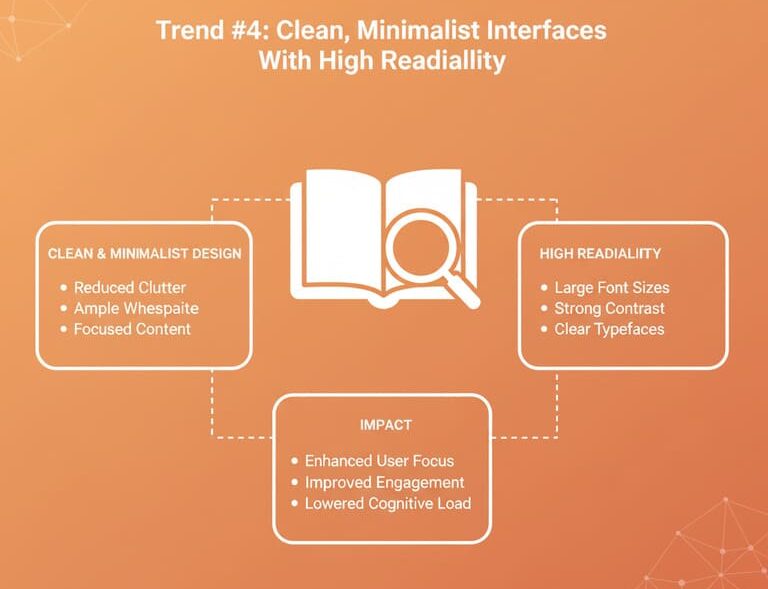
Singaporeans love clean, uncluttered digital experiences. Minimalism continues to dominate local design preferences.
Characteristics of Singapore’s Preferred Minimalist Web Design
- White space
- Modern typography
- Clear hierarchy
- No unnecessary animations
- Simple navigation structure
Why Minimalism Works So Well
Minimal design helps users:
- absorb information faster
- avoid decision fatigue
- navigate easily
- focus on the main CTA
Revenue Impact
A simplified website improves:
- user trust
- readability
- brand professionalism
- conversion rates
This is why most companies requesting website design services Singapore specifically ask for a “clean and modern” look.
Trend #5: Conversion-Focused Layouts (CRO-Driven Design)
Many businesses in Singapore now understand that a website is not just an online brochure—it’s a digital salesperson. This shift has brought Conversion Rate Optimization (CRO) into mainstream web design.
CRO-Focused Elements Include
- Strong hero section with clear value proposition
- Social proof: reviews, case studies, testimonials
- Sticky contact/WhatsApp buttons
- Fewer form fields
- Clear CTA hierarchy
- Benefit-driven copywriting
Why CRO Matters
Businesses that update their websites with CRO elements often see:
- 2–4x more enquiries
- lower cost-per-lead in ads
- increased trust from potential customers
A CRO-focused approach means that website design services Singapore aren’t just about appearance—they’re about real business outcomes.
See More: Web Design vs. Web Development: What’s the Difference?
Trend #6: Authentic Localisation & Singapore-Specific UX
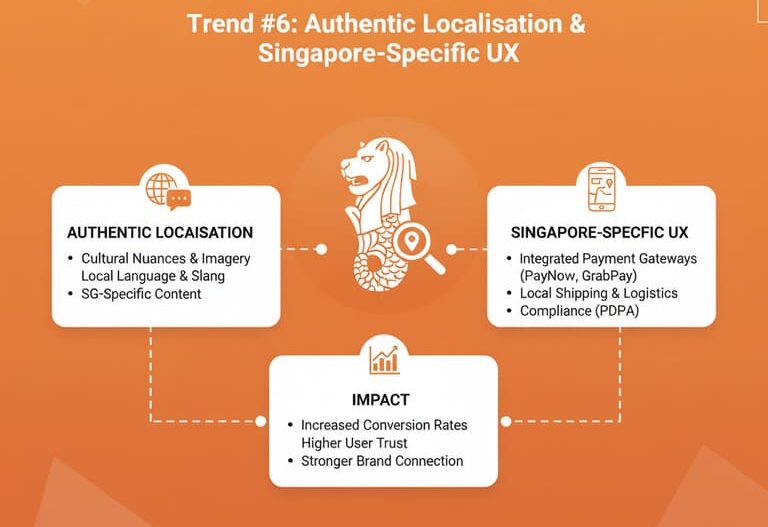
Singapore’s audience is unique. They expect clarity, efficiency, and trustworthy communication.
Singaporean Users Prefer
- concise copywriting
- straightforward navigation
- fast load time
- clean spacing
- prominent contact options
Localised Elements That Work Well
- Singapore landmarks in hero images
- SG WhatsApp icon, SGdollar pricing
- Local testimonials
- Maps, MRT icons
- Familiar design patterns
How Localisation Increases Revenue
Localized design helps businesses appear more credible, relevant, and trustworthy—three factors Singaporean consumers prioritize heavily when deciding to buy.
When companies invest in website design services Singapore, they often request localised UX to appeal directly to local shoppers and clients.
See More: 10 Crucial Elements for High-Converting eCommerce Homepage Design
Trend #7: Story-Led Branding & Emotional Design
Website visitors today care about more than features—they want narrative.
Story-Based Design Includes
- brand mission and values display
- founder story
- behind-the-scenes images
- customer success stories
- brand personality in copywriting
Why Storytelling Works
Storytelling creates emotional connection—a key component in building brand loyalty.
Revenue Impact
- Higher trust leads to higher conversions
- Brand differentiation reduces price sensitivity
- Customers remember and return to your brand
This approach is especially effective in Singapore’s competitive industries like F&B, education, property, coaching, and wellness.
See More: UX or SEO? Why a Professional Website Designer Needs Both
How These 7 Trends Come Together to Influence Web Design in Singapore
A high-performing modern website does not rely on one trend alone. The best-performing websites combine:
- Speed
- Responsiveness
- Clean design
- AI and modern technology
- CRO
- Localised UX
- Brand storytelling
Together, these elements create an online experience that attracts users, keeps them engaged, and motivates them to take action—turning an ordinary website into a powerful revenue engine.
Over the past few years, expectations for website design services Singapore have shifted from “make it look nice” to “help my business grow.” These trends reflect exactly that evolution.
8 Common FAQs About “Website Design Services Singapore”
1. What should I look for when choosing website design services in Singapore?
When evaluating website design services Singapore, focus on several key areas that directly influence your website’s long-term performance:
- User Experience (UX) Expertise: The agency should understand user behaviour, Singapore browsing preferences, and how to structure content for easy navigation.
- Mobile-First Approach: With most Singaporeans accessing websites via mobile, the design must be thumb-friendly, responsive, and fast.
- Page Speed Optimization: Ask whether they follow Google Core Web Vitals standards—slow loading sites lose ranking and conversions.
- SEO-Friendly Structure: The agency should understand on-page SEO, internal linking, schema markup, and content hierarchy.
- Conversion Strategy: Look for agencies familiar with CRO (Conversion Rate Optimization) techniques such as clear CTAs, sticky buttons, and lead funnels.
- Industry Understanding: Agencies familiar with your niche (F&B, education, medical, real estate, etc.) can design more effective solutions.
- Transparent Project Workflow: Clear communication, milestones, and revision processes reduce delays.
A good web design company shouldn’t just “design a website.” They should design a website that attracts users, converts leads, and aligns with your business goals.
2. How long does a website project usually take in Singapore?
Website timelines in Singapore vary depending on project size, complexity, and content readiness:
General Timeline Guide
- Basic corporate website (5–8 pages): 3–5 weeks
- Standard business website (8–15 pages): 4–8 weeks
- E-commerce website: 6–12 weeks
- Custom web applications: 3–6 months
Factors That Affect Timeline
- Content creation delays (most common reason for project slowdown)
- Number of revision rounds
- Special features like booking systems, multi-language setup, member login, or API integrations
- Client approval speed
- Custom design vs template
To avoid delays, ensure content is prepared early and the project scope is clearly defined from the start.
See More: 7 Critical Website Development Factors for Conversions
3. What is included in typical website design services Singapore?
Most agencies in Singapore provide a package that covers the essential components needed to build a functional, visually appealing, and high-performing website.
Common Inclusions
- Custom website design (UI/UX)
- Frontend & backend development
- Mobile-responsive layout
- Basic SEO implementation (meta tags, headings, alt text, clean URL structure)
- Copywriting support or content placement
- CMS setup (WordPress, Shopify, Webflow, etc.)
- Security setup (SSL, anti-spam, firewall)
- Testing & bug fixing
- Launch & deployment support
Optional Add-Ons
- Multi-language setup
- Ongoing maintenance & updates
- eCommerce backend training
- Professional copywriting
- Custom integrations (CRM, ERP, POS, delivery platforms)
- On-page SEO optimisation
Understanding what is included helps avoid additional costs later.
4. Do websites in Singapore need SEO-friendly design?
Absolutely. In Singapore’s competitive digital landscape, an SEO-friendly website is essential for visibility and long-term traffic growth.
Why SEO-Friendly Design Is Critical
- Google ranking depends heavily on UX, speed, and structure
- Local consumers rely on search engines to validate businesses
- SEO-friendly sites reduce ad spend over time
Key SEO-Friendly Design Elements
- Clean code and fast loading
- Optimised images and media
- Logical content hierarchy (H1, H2, H3)
- Mobile-first structure
- SEO-ready CMS
- Schema markup
- Internal linking structure
- Crawlable pages
Without SEO built into the design, you risk having a beautiful website that nobody can find.
See More: 5 Best Website Builders for Small Business in 2025
5. Why is mobile-first design so important in Singapore?
Singapore has one of the highest mobile usage rates in Asia, making mobile-first design a necessity rather than a trend.
Reasons Mobile-First Is Critical
- Over 70% of website traffic in Singapore comes from mobile devices
- Users expect pages to load in under 3 seconds
- Many leads come from mobile-first channels (TikTok, Facebook, WhatsApp, Google Maps)
- Mobile users prefer quick actions such as click-to-call, WhatsApp chat, and instant booking
Mobile-First Features That Improve Conversion
- Sticky call/WhatsApp buttons
- Simple, thumb-friendly navigation
- Short, scannable text
- Lightweight animations
- Prioritized content hierarchy
- Mobile-optimised forms
Websites that perform well on mobile consistently generate more leads and higher sales.
6. How much does website design cost in Singapore?
Costs for website design services Singapore vary widely based on design complexity, number of pages, and required features. The following breakdown gives a more accurate picture:
Pricing Guide
- Template-based website: SGD 800 – SGD 2,000
- Standard corporate website: SGD 2,000 – SGD 6,000
- Custom-designed website: SGD 5,000 – SGD 15,000
- eCommerce website: SGD 3,000 – SGD 20,000+
- Custom web application: SGD 10,000 – SGD 100,000+
Factors That Influence Pricing
- Type of CMS (WordPress, Shopify, Webflow)
- Custom animations or illustrations
- Multi-language support
- Booking, membership, or payment systems
- Number of design revisions
- SEO requirements
- Content creation needs
Cheaper isn’t always better. What matters is long-term ROI, security, speed, and user experience.
See More: Think Your Website Looks Fine? Here’s What a Top Web Design Company Sees Differently
7. Do Singapore businesses benefit from AI-driven website features?
Yes—AI features are becoming increasingly common in modern websites because they significantly improve engagement and user satisfaction.
Popular AI Features
- AI chatbots for instant responses
- Smart product recommendations for eCommerce
- AI-generated FAQs
- Predictive search suggestions
- Lead qualification bots
- AI-driven personalisation (showing relevant content based on visitor behaviour)
Business Benefits
- Better customer support without increasing manpower
- Higher conversion rates due to personalised interactions
- More efficient lead management
- Reduced bounce rate through intelligent suggestions
- 24/7 availability for enquiries
AI makes websites smarter and more capable of converting traffic into actual sales.
8. How often should I redesign my website?
Most Singapore businesses update or redesign their website every 2–3 years, but this depends on industry trends and technology changes.
Signs You Need a Redesign
- Slow loading speed
- Outdated design or poor mobile experience
- Low Google rankings
- High bounce rate
- Difficult navigation
- Unsupported plugins or security issues
- Branding updates or new services
- Declining conversion rates
Why Regular Redesign Matters
- Technology evolves quickly
- Singapore audiences prefer modern, clean interfaces
- Competitors frequently upgrade their websites
- SEO requirements change yearly
- User expectations become more sophisticated
A timely redesign keeps your digital presence current, trustworthy, and competitive.

